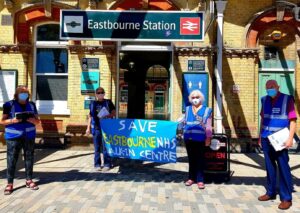
Eastbourne before the railway.
Eastbourne originated as a small fishing community with scattered hamlets along the Sussex coast. The early settlement centered on the village near St Mary’s Church in Old Town (where the spring that becomes the Bourne river merges and gives the town its name), with the village of Meads and Seahouses close by. Fishing, sheep grazing on the South Downs, and small-scale farming were the main livelihoods. The coastline was vulnerable to erosion and still is.
The starting place of the Radical History Tour is the Station without which there would be no town or Radical History in our town.
Travel to Eastbourne before the railway was by coach, horse, or coastal boat keeping Eastbourne relatively quiet compared with the later expansion.
Eastbourne was purposedly develop as a health and seaside retreat by its wealthy families and landowners. Brighton had been developed as a resort with sea-bathing becoming fashionable, attracting visitors seeking the reputed benefits of saltwater and fresh air. Eastbourne’s landowners wanted in on the action but were intent on building a classier more exclusive resort than Brighton. The first thing that was required, of course, was the lobbying for a railway.
The railway first came to Eastbourne on 14th May 1849 when 90% of the town was owned by just 2 families, the Davies-Gilbert family (notably Carew Davies-Gilbert), who owned about a quarter of the town, and the Cavendish family (notably William Cavendish, the seventh Duke of Devonshire), who owned about two thirds of the town.
From 1859, plans were laid out to build an entirely new town to attract the higher echelons of society to either live or to holiday here. A new resort “built for gentlemen by gentlemen”.
This Eastbourne Station Terminus was the 4th station to be built over a 37-year period. The Davies-Gilbert family paid for the Terminus Road to be built and did not want their estates in the Upperton part of Eastbourne to be cut off by the rail track. So, the railway terminus was re-sited from its previous position at the site where Turkuaz now stands, over the mini roundabout to the right. Before the new road was built,there was only a track from the station going across cornfields to the Seahouses area.